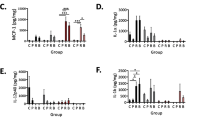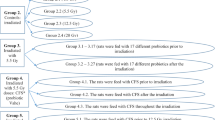Abstract
In mice at 4 days after X-ray-irradiation at 0.5 Gy/min for 16 min, the tissue weights of immune organs, i.e., thymus and spleen, were decreased due to injury to lymphocytes by the X-rays. The resulting immunosuppressive condition allowed the growth of lactobacilli, i.e., L. murinus, which contained LacβTH-DG and possessed the ability to induce transcription of the fucosyltransferase gene for synthesis of FGA1. LacβTH-DG was detected in the jejunal and ileal contents of X-ray-irradiated mice, but not in those of control mice, whereas LacTetH-DG of L. johnsonii was present in the stomach and caecal contents of both mice. The amounts of FGA1 in the duodenal and jejunal tissues of X-ray-irradiated mice increased to 4- and 9-fold of those in controls, respectively. Reflecting the enhanced fucosylation of GA1, the total amounts of FGA1 excreted into the contents of X-ray-irradiated mice were 1.4-times higher than those in controls. Also, when the extent of enhanced fucosylation of GA1 in several regions of the digestive tracts of X-ray-irradiated mice was compared with that in immune deficient nude, scid and pIgR(−/−) mice, the more than 4-fold increases of FGA1 observed in duodenal and jejunal tissues corresponded to those in pIgR(−/−) mice without secretory IgA. Since an increased amount of FGA1 in the small intestine was observed only 4 days after X-ray-irradiation, and diminished synthesis of FGA1 occurred on administration of penicillin and streptomycin, fucosylation of GA1 in the small intestine was revealed to occur quickly in response to a change in the intestinal bacterial population.


Similar content being viewed by others
Abbreviations
- ᅟ:
-
The nomenclature for glycolipids is based on the recommendations of the IUPAC-IUB Commission on Biochemical Nomenclature [1]
- Fs:
-
Forssman antigen
- GA1:
-
asialo GM1
- FGA1:
-
fucosyl GA1
- FGM1:
-
fucosyl GM1
- DH-DG:
-
dihexaosyl diglycerides
- TH-DG:
-
trihexaosyl diglycerides
- TetH-DG:
-
tetrahexaosyl diglycerides
- LacDH-DG:
-
Lactobacillus DH-DG, Galα1-2Glcα1–3’DG
- LacTH-DG:
-
Galα1-6Galα1-2Glcα1–3’DG
- LacβTH-DG:
-
Glcβ1-6Galα1-2Glcα1–3’DG
- LacTetH-DG:
-
Galα1-6Galα1-6Galα1-2Glcα1–3’DG
- Sta:
-
Saphylococcus
- Str:
-
Streptococcus
- MRS:
-
deMan, Rogosa and Sharpe
- PBS:
-
phosphate-buffered saline
References
IUPAC-IUB: Commission on Biochemical Nomenclature. Eur. J. Biochem. 179, 11–21 (1977)
Suzuki, A., Yamakawa, T.: The different distribution of asialo GM1 and Forssman antigen in the small intestine of mouse demonstrated by immunofluorescence staining. J. Biochem. 90, 1541–1544 (1981)
Iwamori, M., Shibagaki, T., Nakata, Y., Adachi, S., Nomura, T.: Distribution of receptor glycolipids for lactobacilli in murine digestive tract and production of antibodies cross-reactive with them by immunization of rabbits with lactobacilli. J. Biochem. 146, 185–191 (2009)
Iwamori, M., Iwamori, Y., Adachi, S., Nomura, T.: Excretion into feces of asialo GM1 in the murine digestive tract and lactobacillus johnsonii exhibiting binding ability toward asialo GM1. A possible role of epithelial glycolipids in the discharge of intestinal bacteria. Glycoconj. J. 28, 21–30 (2011)
Iwamori, M., Sakai, A., Minamimoto, N., Iwamori, Y., Tanaka, K., Aoki, D., Adachi, S., Nomura, T.: Characterization of novel glycolipid antigens with an α-galactose epitope in lactobacilli detected with rabbit anti-lactobacillus antisera and occurrence of antibodies against them in human sera. J. Biochem. 150, 515–523 (2011)
Iwamori, M., Nakasa, M., Yamazaki, K., Iwamori, Y., Tanaka, K., Aoki, D., Adachi, S., Nomura, T.: Bacterial species-characteristic profiles of molecular species, and the antigenicity of phospholipids and glycolipids in symbiotic lactobacillus. Staphylococcus and Streptococcus species. Glycoconj. J. 29, 199–209 (2012)
Iwamori, M., Iwamori, Y., Matsumoto, S., Adachi, S., Nomura, T.: Enhanced expression of fucosyl GA1 in the digestive tract of immune-deficient scid, nude and pIgR(−/−) mice. J. Biochem. 154, 541–549 (2013)
Iwamori, M., Iwamori, Y., Adachi, S., Nomura, T.: Changes in bacterial glycolipids as an index of intestinal lactobacilli and epithelial glycolipids in the digestive tracts of mice after administration of penicillin and streptomycin. Glycoconj. J. 30, 889–897 (2013)
Iwamori, M., Tanaka, K., Adachi, S., Aoki, D., Nomura, T.: Absence of lactobacilli containing glycolipids with the α-galactose epitope and the enhanced fucosylation of a receptor glycolipid GA1 in the digestive tracts of immune-deficient scid mice. J. Biochem. 158, 73–82 (2015)
Karlsson, K.A.: Animal glycosphingolipids as membrane attachment sites for bacteria. Annu. Rev. Biochem. 58, 309–350 (1989)
Yamamoto, K., Miwa, T., Taniguchi, H., Nagano, T., Shimamura, K., Tanaka, T., Kumagai, H.: Binding specificity of lactobacillus to glycolipids. Biochem. Biophys. Res. Commun. 228, 148–152 (1996)
Neeser, J.R., Granato, D., Rouvet, M., Servin, A., Teneberg, S., Karlsson, K.A.: Lactobacillus johnsonii La1 shares carbohydrate-binding specificities with several enteropathogenic bacteria. Glycobiology. 10, 1193–1199 (2000)
Umesaki, Y., Setoyama, H., Matsumoto, S., Imaoka, A., Itoh, K.: Differential roles of segmented filamentous bacteria and clostridia in development of the intestinal immune system. Infect. Immun. 67, 3504–3511 (1999)
Bry, L., Falk, P.G., Midtvedt, T., Gordon, J.I.: A model of host-microbial interactions in an open mammalian ecosystem. Science. 273, 1380–1383 (1996)
Iwamori, M., Kaido, T., Iwamori, Y., Ohta, Y., Tsukamoto, K., Kozaki, S.: Involvement of the C-terminal tail of Arthrobacter ureafaciens sialidase isoenzyme M in cleavage of the internal sialic acid of ganglioside GM1. J. Biochem. 138, 327–334 (2005)
Iwamori, M., Ohta, Y., Uchida, Y., Tsukada, Y.: Arthrobacter ureafaciens sialidase isoenzymes, L, M1 and M2, cleave fucosyl GM1. Glycoconj. J. 14, 67–73 (1997)
Lin, B., Hayashi, Y., Saito, M., Sakakibara, Y., Yanagisawa, M., Iwamori, M.: GDP-fucose: beta-galactoside α1,2-fucosyltransferase, MFUT-II, and not MFUT-I or -III, is induced in a restricted region of the digestive tract of germ-free mice by host-microbe interactions and cycloheximide. Biochim. Biophys. Acta. 1487, 275–285 (2000)
Iwamori, M., Domino, S.E.: Tissue-specific loss of fucosylated glycolipids in mice with targeted deletion of α1,2-fucosyltransferase genes. Biochem. J. 380, 75–81 (2004)
Lin, B., Saito, M., Sakakibara, Y., Hayashi, Y., Yanagisawa, M., Iwamori, M.: Characterization of three members of murine α1,2-fucosyltransferases: change in the expression of the Se gene in the intestine of mice after administration of microbes. Arch. Biochem. Biophys. 388, 207–215 (2001)
Domino, S.E., Zhang, L., Lowe, J.B.: Molecular cloning, genomic mapping, and expression of two secretor blood group α1,2-fucosyltransferase genes differentially regulated in mouse uterine epithelium and gastrointestinal tract. J. Biol. Chem. 276, 23748–23756 (2001)
Author information
Authors and Affiliations
Corresponding author
Ethics declarations
Conflict of interest
The authors declare that they have no conflicts of interest.
Ethical approval
This article does not contain any studies with human participants or animals performed by any of the authors.
Rights and permissions
About this article
Cite this article
Iwamori, M., Tanaka, K., Adachi, S. et al. Enhanced fucosylation of GA1 in the digestive tracts of X-ray-irradiated mice. Glycoconj J 34, 163–169 (2017). https://doi.org/10.1007/s10719-016-9746-3
Received:
Revised:
Accepted:
Published:
Issue Date:
DOI: https://doi.org/10.1007/s10719-016-9746-3




